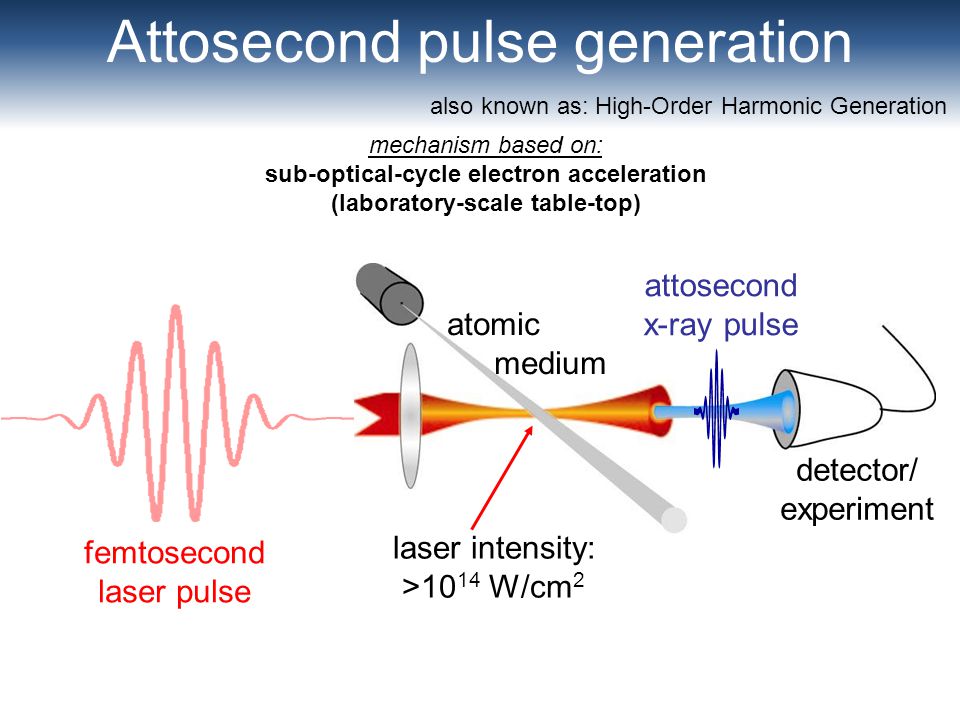The 2023 Nobel Prize in Physics was awarded to Pierre Agostini, Ferenc Krausz and Anne L’Huillier for developing an attosecond pulse of light. The pulse was in attosecond duration, 10-18 s, 1,000 times shorter than a femtosecond laser pulse. (The current record is ~40 attoseconds) The duration of the pulse is comparable to or shorter than the time it takes for an electromagnetic field to change its sign or direction from positive to negative or vice versa. The optical cycle for 500 nm light is typically 10-15 s or 1 fs. This cycle means that the phase of the EM field is important when considering optical attosecond pulses.
Let’s consider a gas sample that emits or absorbs photons at a particular wavelength. Quantum mechanics predict (with probability) that the atoms in the gas will make random quantum jumps between energy levels. Still, we do not know which atom in the gas will make the jump and at what time it will jump. With an attosecond pulse, confirming which individual atom is performing a quantum jump became possible. This finding has aided in the further understanding of electron dynamics in matter.
According to Bohr’s model, the electron dynamics in an atom is blazingly fast (more than 2 (106 m/s). Therefore, a time resolution of below 5′ 10-17 s or 50 attoseconds is needed to detect an electron moving within an atomic scale of 1 angstrom. This speed is many orders of magnitude faster than any experimental techniques available. Hence, observing how the electrons “move” is impossible. According to quantum-mechanical predictions, we can only visualise electron distribution as a probability distribution of electron clouds called “orbitals” associated with certain “energy levels”. Now, we have tools like scanning electron microscopy that allow us to observe the atoms with less than one-angstrom resolution. In most recent research, it is also possible to hold and control the position of a single atom with delicate “optical tweezers” based on super-oscillatory fields.
The development of pulsed lasers using the mode-locking technique dates back to the late 1960s. The use of titanium-doped sapphire (Ti: sapphire) crystals as broadband gain medium enabled the generation of an even shorter (ultrashort) femtosecond laser, which Dr Peter Moulton pioneered at the Massachusetts Institute of Technology (MIT).
The figure above illustrates the time evolution of the electric field (orange line) of an ultrashort optical pulse (dotted blue line). An ultrashort optical pulse (in fs regime) showing the non-periodic electric field oscillations and finite carrier-envelope phase.
This innovation led to a few femtosecond pulses, which are very fast for a pulse of light and so fast that the pulse of light is no longer a periodic electric-field oscillation, i.e. there are only a few cycles within a pulse. But this few-cycle pulse is still not fast enough to image electron dynamics in 10-16 seconds.
To produce attosecond pulses with a very high intensity, one can start with a fairly long wavelength and slow period laser pulse (usually in the near-infrared range, like an 800 nm femtosecond laser). The pulse is then focused onto a gas cell or jet, usually noble gases such as helium or argon. The highly nonlinear process of high harmonic generation (HHG) would produce a burst of single-cycle attosecond pulse composed of extremely broadband light that covers the entire visible range up to ultraviolet (XUV) or soft X-ray wavelengths.
The HHG processes can be explained by a three-step model of photo-ionisation, acceleration and recollision, introduced by Paul Corkum. First, the femtosecond laser pulse’s strong electric field ionises the atoms, creating a plasma of free electrons. The process is called photo-ionisation, and Leonid Keldysh, a Russian physicist, first developed the underlying theory. The free electrons are then accelerated by the laser field and gain significant kinetic energy to move away from the attraction of the ionised atom. As the laser’s electric field reverses its direction, the electrons undergo a process known as recollision.
Some of the electrons are driven back towards the ionised atom by the oscillating electric field of the laser pulse and the attraction force of the nucleus. The accelerated electron recombines with the ionised atom, and the energy gained by the electron during acceleration is released in the form of high-harmonic photons, which have a frequency much higher than the frequency of the original laser pulse. A summarised illustration of the process is shown in Figure 2.

The attosecond electron pulse will be fast enough to capture electrons in motion, and this helps the resolution in microscopy. For example, the electron microscope images are a little blurry, and we may see that the atoms are not very confined. The electron moves so fast that it is seen as not sitting still at a specific point. Due to the probing light’s limited (time) resolution, we see the electron making a cloud around the atoms.
In information technology, the attosecond pulses can transmit information at a higher rate and with greater information capacity. This increased speed means that, in principle, faster internet and network systems would be possible.
Attosecond pulse opens up new capabilities in atto-electronics, providing new applications and helping answer fundamental questions by directly measuring light waves, real-time observation of valence electron motion and ultrafast electron dynamics in molecules.




